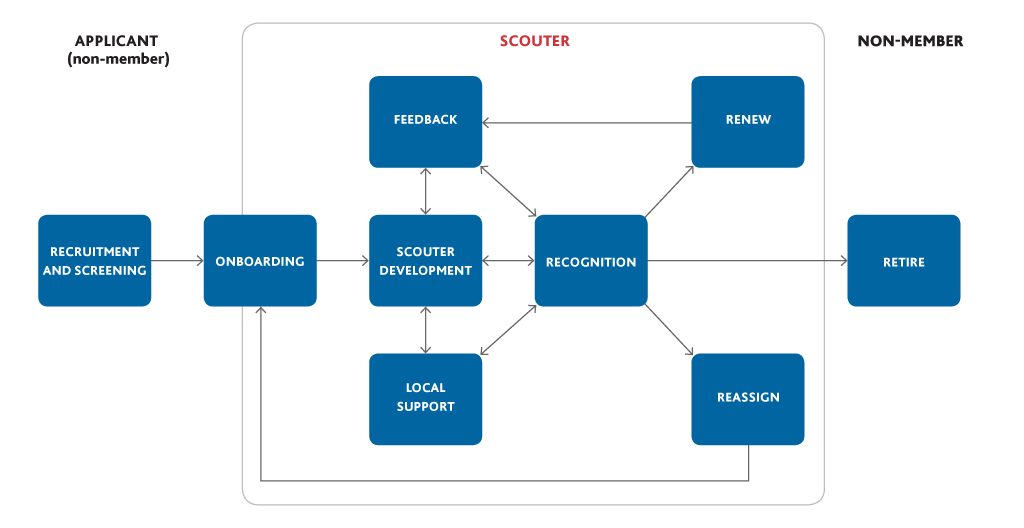| < Program Quality | Volunteer Support | Group Capacity > |
| < Program Quality | Volunteer Support | Group Capacity > |
Scouting is made possible by the thousands of engaged volunteers that contribute their time to creating a better world. We know that volunteer engagement is largely driven by the support provided by the supervising Commissioner through the Volunteer Support Strategy. The three main drivers of volunteer engagement are onboarding, local support and constructive feedback.
| Volunteer Support Strategy |
| N/A |
| New Scouter Welcome Kit |
| Scouter Support Playbook |
| Interview Assessment Summary |
| Onboarding Process |
| Onboarding Timeline and Plan |
| Appointment of Scouters Standard |
| Scouts Canada Code of Conduct |
Providing new Scouters with a meaningful orientation to their Group, and Scouting in general, is incredibly important to their development. New Scouters join because they want to contribute to Scouting and it’s the Group Committee’s role to ensure they’re set up to succeed. When onboarding new Scouters, Group Committee members should use the New Scouter Welcome Kit as a key resource.
Scouter onboarding happens in five stages and involves various members of the Group. It is the Group Commissioner’s role to ensure a quality orientation happens, and that Sections properly onboard new Scouters.

| Wood Badge II Guide |
| Wood Badge II Support Scouter Guide |
| GC Wood Badge II |
| Accessibility Training |
| WBI FAQs |
| Scouter Development Model |
| Scouter Development Map |
| N/A |
We achieve our Mission by empowering communities to provide young people with quality Scouting programs facilitated by Volunteers. Therefore, ensuring that our Volunteers are equipped with the knowledge and skills to be successful is critical if we want to make Scouting accessible to as many youth as possible. The Scouter Development model for learning equips Volunteers with the knowledge and skills to be successful using elements of the Scout Method.

Support Scouters help Scouters develop and implement Scouter Development plans. An ideal Support Scouter will have experience in the learner’s Scouting role, will be familiar with available supporting resources and will be locally available to provide in-person support.
Supported learning can be broken down into three broad methods chosen by the Scouter based on his or her personal learning preference:
Scouts Canada is a great place to volunteer because Scouters are generally happy to help and support each other. Performance management is helping people to be accountable for work that they have committed to. Group Commissioners have a special relationship with performance management because they are accountable for the performance of the Scouters in their Group. They are also responsible for appointing new Volunteers and reappointing, reassigning, or retiring Volunteers at the end of the Scouting Year.
In Scouting, performance management happens through the Volunteer Support Cycle and can be described in terms of Plan-Do-Review. This is very similar to professional performance management systems, which typically use the terminology Plan-Monitor-Evaluate. Regardless of the terminology, the logic is the same: help the Volunteer set goals for the year, support them and monitor their progress towards the goal, and finally review and evaluate how they did.
Scouts Canada’s Volunteer Support Strategy—and its cyclical support components—are the backbone of the Volunteer performance management process. Just like many other processes within Scouts Canada, performance management can be described as Plan-Do-Review.
Renew
Invite the Volunteer to return for another great year in the same Scouting role.
Retire
Thank the Volunteer for his or her contributions to Scouting as he or she leaves the movement.
Reassign
Work with the Volunteer to find a new Scouting role better aligned with his or her interests and talents.
| 1. Passive Management | 2. Thoughtful Management | 3. Proactive Management | 4. Management Excellence | |
| Volunteer Support | Volunteers receive limited support. | Performance management and feedback are used as intervention tools; some key Volunteers have Scouter Development plans. | Volunteer performance is reviewed annually; Volunteers receive constructive feedback seasonally and have Scouter Development plans. | All aspects of the Volunteer Support Cycle are critical components of Group culture. |